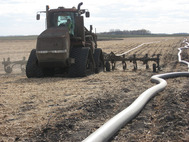
Several farm best management practices (BMPs) are a win-win-win: They protect water quality, soil health AND air quality, according to two new reports from the Minnesota Pollution Control Agency (MPCA) and the Board of Water and Soil Resources (BWSR).
MPCA’s technical report, Greenhouse Gas Reduction Potential of Agricultural Best Management Practices, estimates the impact of 21 different agricultural conservation practices. The most beneficial practices are those that get more perennial vegetation on the land, including hedgerows, shelterbelts, buffers, grass waterways, and filter strips. Practices such as reduced tillage, nutrient management, and cover crops can be effective strategies for existing cropland. Scientists say that though emission reductions per acre are small, implementing best management practices across the 20 million acres of Minnesota cropland could reduce overall agriculture emissions by up to 10% — the air pollution equivalent of taking thousands of cars off the road.
BWSR’s report, Climate Change Trends and Action Plan, examined the impact of state-funded conservation programs and practices on private lands, which make up about 75% of Minnesota’s land area. In the report, BWSR scientists identified the greenhouse gas emission reductions provided through agricultural conservation practices, retirement of marginal agricultural lands, and wetland conservation and restoration. Recently implemented conservation measures are already making a positive impact on greenhouse gas emissions. Combined, BWSR programs have helped reduce greenhouse gas emissions by the equivalent of 600,000 tons of CO2, or 2.2% of estimated emissions from cropland in Minnesota.
Through the Minnesota Department of Agriculture’s Minnesota Agricultural Water Quality Certification Program (MAWQCP), farmers across the state have implemented nearly 1,700 new conservation practices. On average, each practice reduces 21 tons of carbon emissions each year. That means Minnesota farmers are keeping more than 36,000 tons of carbon dioxide emissions out of the atmosphere.
|

Registration is now open for the 2019 Minnesota Environmental Congress that will focus on “The climate for action is changing.” The congress will run Dec. 3, from 9 a.m. – 5:30 p.m., with check-in beginning at 8 a.m., at the Centennial Student Union at Minnesota State University-Mankato, 620 South Road W in Mankato.
This conference will include sessions on community preparedness, innovative practices in agriculture, transitioning to a low-carbon transportation system, protecting water resources, and more. Participants will lead discussion groups in the afternoon and contribute ideas on to work together in new, equitable, and creative ways to take meaningful action.
There is no fee to attend but space is limited and preregistration is required; register here to reserve your spot.
For more information about the event visit EQB’s website.
|

After crops are harvested, Minnesota livestock producers will be applying billions of gallons or pounds of stored manure to cropland. Wet weather is complicating the harvest, but it also plays a role in proper manure management.
To get the most value from manure as fertilizer and to avoid manure runoff that could pollute nearby lakes and streams, the MPCA and the Minnesota Department of Agriculture are reminding farmers to observe application setbacks from bodies of water and use proper manure-application rates. Detailed guidance is available on the MPCA web site. Avoid applying manure just prior to predicted rainfall, and reduce your application rates if field and weather conditions are not ideal. The Minnesota Department of Agriculture’s Runoff Risk Advisory Forecast tool can help determine the best time to apply manure to a field. If the Runoff Risk forecast is moderate or severe, applicators should reevaluate the locations or dates for applying manure.
See the full story on the MPCA website.
|

Cities across Minnesota are working to reduce chloride pollution to lakes and streams, usually by reducing road salt use or by reducing salty discharges to their wastewater treatment plants. The MPCA is pleased to announce two new resources to help cities with these efforts:
- Suite of model ordinances to regulate deicers
- Guide for a water softener rebate program
The MPCA partnered with the Nine Mile Creek Watershed District, TetraTech, several local cities and watershed organizations to develop these resources:
- The model ordinance serves as guidance for municipal officials who want direction in regulating the use of deicers to protect water quality, animals, human health and infrastructure. The language was adapted from existing code from mid-western localities along with the MPCA’s Smart Salting and deicer management guidance. Local governments may want to institute regulatory options voluntarily or as part of their MS4 program. They may also tailor the language to their needs.
- The rebate program guide is for city or watershed staff who have determined that water softeners are a significant source of the chloride load to their wastewater treatment facility. The guide covers the general steps for developing a program to offer residents a rebate for optimizing, upgrading or removing their water softeners.
For additional resources, please visit the Statewide chloride resources webpage or contact Brooke Asleson, MPCA water pollution prevention coordinator, at 651 757-2205 or brooke.asleson@state.mn.us.
|
Property owners and managers can now learn to apply less salt on their property - and save money - while preserving the area’s valued surface and groundwater resources. Participants determine ways to maintain safe winter surfaces for their building occupants and customers, but with less salt. Those trained have already cut their salt use by 30-70%! Imagine paying that much less for salt this winter – it can add up to significant cost savings!
Minnesota has a growing salty water problem that threatens its freshwater fish and other aquatic life. Chloride from both de-icing salt and water softener salt gets into lakes and streams, and groundwater that supplies drinking water. It takes only 1 teaspoon of salt to permanently pollute 5 gallons of water. Once in the water, there is no easy way to remove the chloride.
Why other managers take the training: Over-salting is having serious side effects on property infrastructure, an expensive ”hidden” cost to over-salting. It eats away at building exteriors near the ground, permanently stains and crumbles sidewalks and driveways, and damages frequently used indoor walkways. The most immediate effect is the familiar springtime vegetation ”burn” from over-salting, which kills the grass near sidewalks, parking lots, and roads.
Be sure to attend the Smart Salting for Property Managers, on Nov. 14, from 9 a.m. - 1 p.m. at the MPCA Duluth Office. The training is free, but registration is required. Lunch included! Register with Karina Heim at karina.heim@wisc.edu. Learn more at the MPCA Smart Salting Training Certification page.
The Minnesota Assoc. of Watershed Districts will hold its annual convention Dec. 5-7 at the Arrowwood Conference Center in Alexandria. For more information, go to www.mnwatershed.org.
The 2019 annual convention for the Minnesota Assoc. of Soil and Water Conservation Districts will be Dec. 8-10 at the DoubleTree Hotel in Bloomington. For more information, go to www.maswcd.org.
The MPCA will have a booth at both events. Be sure to stop by for the latest on Clean Water Partnership funding and other programs.
The U.S. Environmental Protection Agency has approved the following Total Maximum Daily Load (TMDL) studies that determine the reductions needed in pollutants in order for lakes and streams to meet water quality standards:
|